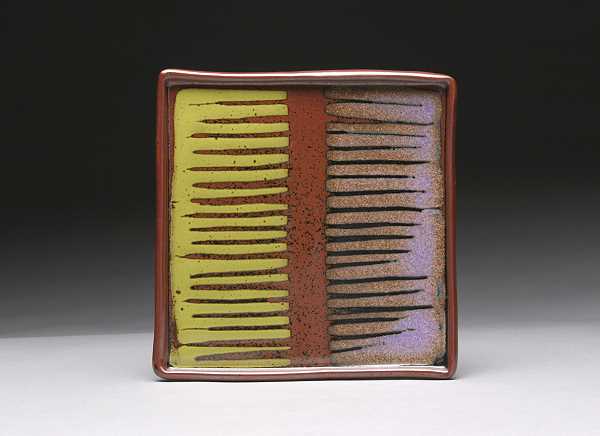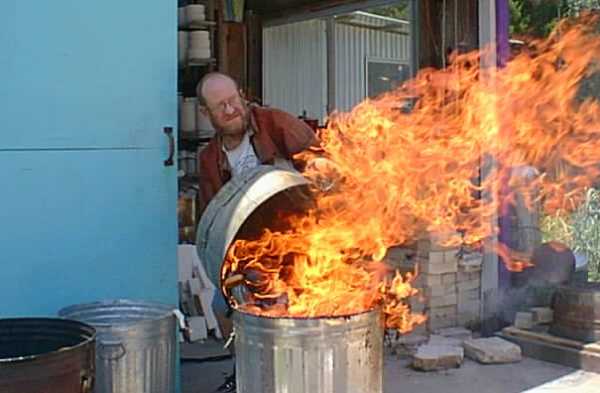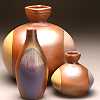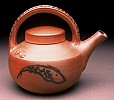
All I Wanted To Do Was Sing: Billy Ray Mangham by Gary C. Hatcher
CERAMICS MONTHLY
June/July/August 1999

Billy Ray Mangham makes life look easy. His confidant amiable persona flavored with a smooth slow Texas drawl make him a joy to be around. But easy living has been far from the truth for Billy Ray Mangham. Underneath this playful appearance is a highly evolved ethos that provides humor but also power to his work.
A thirty-year pursuit of communicating deep metaphysical and societal truths via art is what he is about. The playful first appearance of the work is the hook. After the viewer is caught in his work true essence begins to be revealed.
This is seen clearly in his "fool" series comprised of clown like busts that are strikingly comical. Upon closer inspection the viewer is provided short haiku like verse on the backs which signaled the "fool" was caught in a web of his own making. Billy Ray interprets the "fool" as one who stands outside of popular reality and time and comments on events witnessed. The viewer wades into the shallow water enticed by humor and then realizes that this work is deep.
Why am I, a potter making functional pots writing about a raku sculpture artist? I have always been in awe of Billy Ray. Year after year his work flows with new creative vitality. He drinks deep of the river of creativity and the work rings true.
Billy Ray was born in Phillips, Texas on a hot July day in 1945. His father was a hard working oil field "company man". He grew up living in an oil field camp of company houses among eight other families. According to Billy Ray, "All of the families were fairly uneducated oil field 'red necks' except for the Olds family." Willeta and Gene Olds made a difference in his Billy Ray's life. Willeta taught art at the Jr. High School and Gene was a rock hound, tinkerer and maker of things. It was at their house filled with exciting junk and in Willeta's 9th grade art classes that Billy Ray was provided a toe hold for a life of art. Willeta and Gene's generosity in helping the young Billy Ray work with tools and his imagination to make wooden toys provided the core for the playful raku sculptures of today.
The seeds of art were sown by Willeta and Gene but it would be many years before Billy Ray would be able to orchestrate his life and direct his energy to the realization of his own creative voice. In 1964 he started playing "rock and roll" and although all he really wanted to do was sing he learned to play the bass guitar. "I played rhythm and blues in honky tonks in Amarillo during the week and teen dances all over the panhandle, Oklahoma and New Mexico on weekends. I was suppose to be going to college but ended up flunking out."
Billy Ray was privileged to go on a four-year tour of Japan, Hong Kong, Thailand, Hawaii, and the Philippines visiting these countries several times courtesy of the U.S. Navy. "Viet Nam was hot in 67 and 68 and I was in serious danger of the draft so I joined the Navy".
After completing his travels with the military he met John Daniel a sculpture professor at Stephen F. Austin State University in Nacogdoches. John directed Billy Ray back on the art track that Willeta and Gene Olds had started him on. At SFA he threw himself completely into creating sculpture. He experimented with every material available: wood, welded steel and plaster, but it was when he touched clay that his life took on a true direction.
At the time Stephen F. Austin State University had no clay department so his pursuit of clay led him to San Jose State University in California where he had Herbert Sanders and James Olevera for teachers. This is where he was first introduced to raku "Once a year we had a great "raku-fest" on a beach north of Santa Cruz. Hundreds of pottery students from local colleges gathered for four or five days, camping and firing raku in a giant party. It was a raku experience in the truest sense of the word.",said Billy Ray.
After completing a BFA at San Jose State University Billy Ray and two friends Ralph Fulton and Ruth Richards set up a pottery back in Nacogdoches, Texas. The quick firing process of Raku gave way to pursuit of the "Leach-Hamada" path. "We made high fire pots for the masses. We built our own house, tried to grow our own food and made functional pots using ash glazes. Our cry was "back to the land". We worked very hard trying to make the dream come true. We had little money, business acumen or skill but we had a dream and were not afraid to work. In the end the partnership was dissolved and I moved on to Austin, having completed an MFA at Stephen F. Austin."
Billy Ray was offered the position of "potter in residence" at The Laguna Gloria Art Museum" Although he taught functional pottery making it was at this time the "Hamada Leach" approach to working began to lose his interest. After ten years of looking at earth tones he began to crave color. The transition from earth tone colors to bright Raku took several years."
Paul Soldner introduced his Americanized version of raku in the 60's and many have applied his simple formula for quick flashy objects to clay with an eager clientele waiting to yeald to this bright attraction. Raku, wood firing and salt glazing are similar in that they can obscure content making process the only element existent in the work. Wood firing has become for many a method of resolving the surface of the work with the artist abdicating prerogative to control and balance elements in the work. These methods of process domination only work if there is content in the form, which needs enhancement by the process. Bringing form, content and process into balance is the dance all clay artist struggle to perform. "Formula" firing becomes a mask that obscures lack of content or poor form.
Content has transcended process in Billy Ray's work. Exquisite craftsmanship and mastery of the firing and glazing process also speak of his attention to every detail. All elements are considered and all are brought into harmony. The work feels right.
How does one construct and fire a four-foot high "man with bird" sculpture or a three-foot long school bus? The techniques have been refined through years of intimate involvement with the clay and firing.
Most works begin with a thrown bullet shape, which become the bodies for the cubist figures, school buses and trucks. Most things are assembled with finishing nails, which are not galvanized and inserted at the leather hard stage. The claybody is one, which has almost no shrinkage, and cracking is rarely a problem. The works are bisqued to cone 08 and raku glaze fired to cone 05. This is close to the limit that the works can be fired without the nails melting.
The primary glaze that Billy Ray uses is one comprised of a 50, 50 mixture of gerstly borate and nephaline synite. This base glaze is combined with stains or commercial low fire glazes to produce various colors.
Today Billy Ray and his wife Beverly, who is also an artist, maintain their studio south of Austin in San Marcos. His work is sold in galleries from all over the United States and sought after by collectors. When asked what the core of his work is Billy Ray responded," I am continually seeking answers to why I have chosen this path. I am working with two now. First clay enables me to focus, concentrate, and pay attention. Paying attention, and being in the present makes me truly alive. The second reason I have chosen this path with clay is that it connects me to the memory and history of our species. As a culture we seem to have lost values and direction that are important to our survival. When I touch clay, I re-connect with those things.



